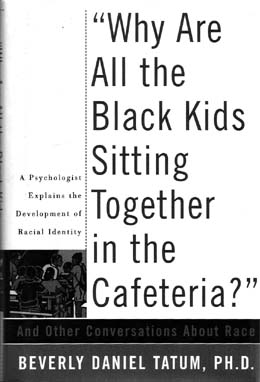Genre Non FictionAuthor Beverly Daniel TatumPrice $14.95
There are those who are itching to know why certain ethnic groups are drawn to each other. These same people also want to know why many racial groups tend to affix themselves to one another in a seeming clique.
Yet they are not satisfied with the easily given answer, obvious in the eyes of those who gave it.
They know with a steadfast certainty that there is something else there, but no one wants to say it.
It’s been exhausted, others think. Just leave it alone. But it’s still not enough.
It is for these purposes that Dr. Beverly Daniel Tatum has written “Why are All the Black Kids Sitting Together in the Cafeteria?”
After speaking extensively on the topic of racial identity development in adults but more importantly in children, Tatum figured that her ideas and proven theories should be solidified in print.
The curiosity still existed, and she needed to satisfy it. Both parents and teachers were wondering. A deeper and wider understanding needed to be established.
In her introduction, Tatum not only speaks of the raging questions continuously being posed by those who are unafraid, but also about public and private conversations on the topic.
Privately, she states that people are not afraid of asking the obvious questions and are fearless of the words that have become dirty in the past.
Words like slavery, racism and racial differences are inevitable when speaking about racial identity development. But public utterances of these words are a seeming impossibility.
In the book, however, Tatum is fearless for her curious public and broaches these topics in a casual, almost roundtable-like tone, that gradually draws the reader in.
In this same conversational manner, Tatum reveals to her reader the testing aspect of her theories, exposing them to her subjects’ mind processes and their preconceived theories.
With one whose curiosity is also coupled with a need for understanding, the subject revelations may seem not only cruel but also trite.
The book lessens the brunt of this blow. One will marvel at the unfair and slighted assumptions and misconceptions revealed.
The reader will only be amazed by what is discovered through the proven words of the author and appalled by the simple things that are true about the secret and unspoken social self.
Perhaps it is indeed a possibility that people want to “stick to their own kind.”
The author reveals every facet of man’s social nature developed first in children, then sustained by adults and expanded upon in the public social sector of today.
Every question, whether simple or complex, is answered within the two hundred and sixty-one pages of Tatum’s book.
For those who are fearful of uttering the wrong words and posing the wrong question, let the fear dissipate with curiosity as every facet of man’s racial and ethic social existence is divulged.






